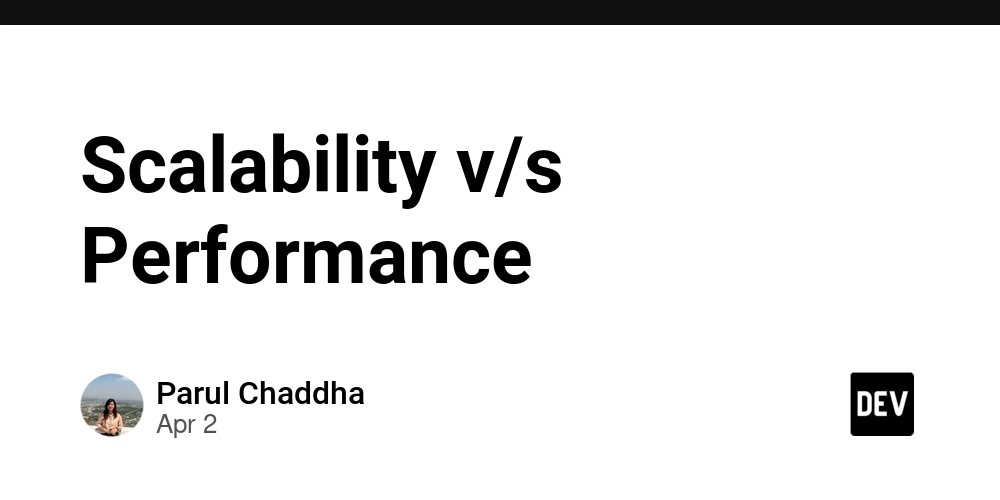Scalability v/s Performance
Have you ever found yourself waiting in a long checkout line at your local supermarket? That everyday experience is a lot like the challenge of balancing performance and scalability in software development. Understanding the Basics Early in my career, I mistakenly thought that performance and scalability were one and the same. Imagine my surprise when my very first project to scale a system ended up making my code run slower—in my development environment, at least! Let’s break it down: Performance is all about speed. It’s how fast your system processes a single request. Scalability is about handling growth—more users, more data, more traffic—while keeping performance steady. While the speed of light remains constant, software speed? Not so much. The Supermarket Analogy Picture a supermarket with a single cashier who checks out one shopper every minute. When just one shopper comes in, everything is smooth. But what happens when two shoppers arrive every minute? Here’s what it looks like: 1st shopper: Checked out in 1 minute. 2nd shopper: Waits 1 minute → Checkout = 2 minutes. 3rd & 4th shoppers: Each one waits even longer. Eventually, the wait time balloons as more shoppers arrive. So what’s happening here? The performance of one cashier is fine under low traffic, but once the flow increases, performance drops rapidly. Scalability to the Rescue Scalability ensures that the system maintains consistent performance even as traffic increases. This might mean building more complex systems that seem "slower" when things are quiet—but the trade-off is worth it when you're handling real traffic. For example, adding more cashiers in our supermarket: Might take slightly longer for a single shopper. But allows the system to handle many more shoppers efficiently. Tactics for Better Scalability 1. Caching Let’s say regulars buy the same items every day. Instead of scanning each item again and again, we give them a special receipt. Scanning this receipt takes 10 seconds, not 1 full minute. Boom. One cashier now checks out 6 people per minute instead of 1. But of course, caching isn’t perfect. Sometimes the receipt (cache) fails: The shopper’s items change daily. It’s a new shopper with no receipt. The receipt (cache) is lost. These are cache misses, and they might make things even slower (e.g., 1 min 10 sec instead of 1 min). 2. Adding More Cashiers More cashiers = more people served. But there’s still complexity: Shoppers might spend time deciding which cashier to approach. If one cashier is slow or gets sick, lines get messed up. Space becomes an issue as lines grow. People might cut the line, causing frustration (and maybe chaos

Have you ever found yourself waiting in a long checkout line at your local supermarket? That everyday experience is a lot like the challenge of balancing performance and scalability in software development.
Understanding the Basics
Early in my career, I mistakenly thought that performance and scalability were one and the same.
Imagine my surprise when my very first project to scale a system ended up making my code run slower—in my development environment, at least!
Let’s break it down:
- Performance is all about speed. It’s how fast your system processes a single request.
- Scalability is about handling growth—more users, more data, more traffic—while keeping performance steady.
While the speed of light remains constant, software speed? Not so much.
The Supermarket Analogy
Picture a supermarket with a single cashier who checks out one shopper every minute.
- When just one shopper comes in, everything is smooth.
- But what happens when two shoppers arrive every minute?
Here’s what it looks like:
- 1st shopper: Checked out in 1 minute.
- 2nd shopper: Waits 1 minute → Checkout = 2 minutes.
- 3rd & 4th shoppers: Each one waits even longer.
- Eventually, the wait time balloons as more shoppers arrive.
So what’s happening here?
The performance of one cashier is fine under low traffic, but once the flow increases, performance drops rapidly.
Scalability to the Rescue
Scalability ensures that the system maintains consistent performance even as traffic increases.
This might mean building more complex systems that seem "slower" when things are quiet—but the trade-off is worth it when you're handling real traffic.
For example, adding more cashiers in our supermarket:
- Might take slightly longer for a single shopper.
- But allows the system to handle many more shoppers efficiently.
Tactics for Better Scalability
1. Caching
Let’s say regulars buy the same items every day.
Instead of scanning each item again and again, we give them a special receipt. Scanning this receipt takes 10 seconds, not 1 full minute.
Boom. One cashier now checks out 6 people per minute instead of 1.
But of course, caching isn’t perfect. Sometimes the receipt (cache) fails:
- The shopper’s items change daily.
- It’s a new shopper with no receipt.
- The receipt (cache) is lost.
These are cache misses, and they might make things even slower (e.g., 1 min 10 sec instead of 1 min).
2. Adding More Cashiers
More cashiers = more people served.
But there’s still complexity:
- Shoppers might spend time deciding which cashier to approach.
- If one cashier is slow or gets sick, lines get messed up.
- Space becomes an issue as lines grow.
- People might cut the line, causing frustration (and maybe chaos




















































%20Abstract%20Background%20112024%20SOURCE%20Amazon.jpg)






















































































































![[The AI Show Episode 142]: ChatGPT’s New Image Generator, Studio Ghibli Craze and Backlash, Gemini 2.5, OpenAI Academy, 4o Updates, Vibe Marketing & xAI Acquires X](https://www.marketingaiinstitute.com/hubfs/ep%20142%20cover.png)
























































































































































































































































-Nintendo-Switch-2-–-Overview-trailer-00-00-10.png?width=1920&height=1920&fit=bounds&quality=80&format=jpg&auto=webp#)





















_Anna_Berkut_Alamy.jpg?#)













































































































![YouTube Announces New Creation Tools for Shorts [Video]](https://www.iclarified.com/images/news/96923/96923/96923-640.jpg)





































































![[Weekly funding roundup March 29-April 4] Steady-state VC inflow pre-empts Trump tariff impact](https://images.yourstory.com/cs/2/220356402d6d11e9aa979329348d4c3e/WeeklyFundingRoundupNewLogo1-1739546168054.jpg)





























































